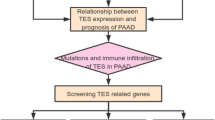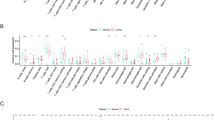Abstract
Background
TNFSF9 gene has been found to play an anti-tumor role and regulate the function of immune cells. However, the prognostic role of TNFSF9 in pancreatic cancer and its relationship with immune cell infiltration have not been studied.
Methods
We used Oncomine, UALCAN, and GEPIA databases to analyze the expression of TNFSF9 in pancreatic cancer. We used Kaplan-Meier plotters, GEPIA, and UALCAN to evaluate the effect of TNFSF9 on clinical prognosis. We further used TIMER to study the correlation between TNFSF9 and cancer immune infiltrate cells. In addition, we used GEPIA to analyze the correlation between TNFSF9 expression and gene markers of immune infiltrate cells.
Results
TNFSF9 mRNA expression level was remarkably increased in pancreatic cancer than that in normal tissues (both P < 0.05). In addition, high TNFSF9 expression was significantly related to poor overall survival (OS) and relapse-free survival (RFS) in pancreatic cancer (OS HR = 2.02, P = 0.0012; RFS HR = 2.63, P = 0.022). Moreover, high TNFSF9 expression in pancreatic cancer patients was associated with worse OS in stage 1 to 2 but not stage 3 and stage 4. Specifically, TNFSF9 expression and CD8+ T cell infiltration of pancreatic cancer was negatively correlated. TNFSF9 expression showed strong correlations with M1 macrophages in pancreatic cancer.
Conclusions
Our results suggest that TNFSF9 is associated with prognosis and CD8+ T cell infiltration levels in patients with pancreatic cancer. Further, TNFSF9 expression potentially contributes to the modulation of M1 polarization of macrophages. These findings indicate that TNFSF9 can be serves as a prognostic biomarker in determining the prognosis of pancreatic cancer and is associated with different types of phenotypes of immune cell infiltration.






Similar content being viewed by others
References
Siegel RL, Miller K, DandJemal A. Cancer statistics, 2018. CA Cancer J Clin. 2018;68:7–30.
Carr R, MandFernandez-Zapico ME. Toward personalized TGFbeta inhibition for pancreatic cancer. EMBO Mol Med. 2019:e11414.
Daley D, Mani VR, Mohan N, Akkad N, Pandian G, Savadkar S, et al. NLRP3 signaling drives macrophage-induced adaptive immune suppression in pancreatic carcinoma. J Exp Med. 2017;214:1711–24.
De Monte L, Reni M, Tassi E, Clavenna D, Papa I, Recalde H, et al. Intratumor T helper type 2 cell infiltrate correlates with cancer-associated fibroblast thymic stromal lymphopoietin production and reduced survival in pancreatic cancer. J Exp Med. 2011;208:469–78.
Ochi A, Nguyen AH, Bedrosian AS, Mushlin HM, Zarbakhsh S, Barilla R, et al. MyD88 inhibition amplifies dendritic cell capacity to promote pancreatic carcinogenesis via Th2 cells. J Exp Med. 2012;209:1671–87.
Fukunaga A, Miyamoto M, Cho Y, Murakami S, Kawarada Y, Oshikiri T, et al. CD8+ tumor-infiltrating lymphocytes together with CD4+ tumor-infiltrating lymphocytes and dendritic cells improve the prognosis of patients with pancreatic adenocarcinoma. Pancreas. 2004;28:e26–31.
Wang X, Luo G, Zhang K, Cao J, Huang C, Jiang T, et al. Hypoxic tumor-derived Exosomal miR-301a mediates M2 macrophage polarization via PTEN/PI3Kgamma to promote pancreatic Cancer metastasis. Cancer Res. 2018;78:4586–98.
Deshmukh SK, Tyagi N, Khan MA, Srivastava SK, Al-Ghadhban A, Dugger K, et al. Gemcitabine treatment promotes immunosuppressive microenvironment in pancreatic tumors by supporting the infiltration, growth, and polarization of macrophages. Sci Rep. 2018;8:12000.
Shen YL, Gan Y, Gao HF, Fan YC, Wang Q, Yuan H, et al. TNFSF9 exerts an inhibitory effect on hepatocellular carcinoma. J Dig Dis. 2017;18:395–403.
Dharmadhikari B, Wu M, Abdullah NS, Rajendran S, Ishak ND, Nickles E, et al. CD137 and CD137L signals are main drivers of type 1, cell-mediated immune responses. Oncoimmunology. 2016;5:e1113367.
Shao ZandSchwarz H. CD137 ligand, a member of the tumor necrosis factor family, regulates immune responses via reverse signal transduction. J Leukoc Biol. 2011;89:21–9.
Langstein J, Michel J, Fritsche J, Kreutz M, Andreesen RandSchwarz H. CD137 (ILA/4-1BB), a member of the TNF receptor family, induces monocyte activation via bidirectional signaling. J Immunol. 1998;160:2488–94.
Maniar A, Zhang X, Lin W, Gastman BR, Pauza CD, Strome SE, et al. Human gammadelta T lymphocytes induce robust NK cell-mediated antitumor cytotoxicity through CD137 engagement. Blood. 2010;116:1726–33.
Mardiana S, John LB, Henderson MA, Slaney CY, von Scheidt B, Giuffrida L, et al. A multifunctional role for adjuvant Anti-4-1BB therapy in augmenting antitumor response by chimeric antigen receptor T cells. Cancer Res. 2017;77:1296–309.
Thum E, Shao ZandSchwarz H. CD137, implications in immunity and potential for therapy. Front Biosci (Landmark Ed). 2009;14:4173–88.
Kwon B. CD137-CD137 ligand interactions in inflammation. Immune Netw. 2009;9:84–9.
Dimberg J, Hugander AandWagsater D. Expression of CD137 and CD137 ligand in colorectal cancer patients. Oncol Rep. 2006;15:1197–200.
Salih HR, Kosowski SG, Haluska VF, Starling GC, Loo DT, Lee F, et al. Constitutive expression of functional 4-1BB (CD137) ligand on carcinoma cells. J Immunol. 2000;165:2903–10.
Qian Y, Pei D, Cheng T, Wu C, Pu X, Chen X, et al. CD137 ligand-mediated reverse signaling inhibits proliferation and induces apoptosis in non-small cell lung cancer. Med Oncol. 2015;32:44.
Rhodes DR, Kalyana-Sundaram S, Mahavisno V, Varambally R, Yu J, Briggs BB, et al. Oncomine 3.0: genes, pathways, and networks in a collection of 18,000 cancer gene expression profiles. Neoplasia. 2007;9:166–80.
Lanczky A, Nagy A, Bottai G, Munkacsy G, Szabo A, Santarpia L, et al. miRpower: a web-tool to validate survival-associated miRNAs utilizing expression data from 2178 breast cancer patients. Breast Cancer Res Treat. 2016;160:439–46.
Li T, Fan J, Wang B, Traugh N, Chen Q, Liu JS, et al. TIMER: a web server for comprehensive analysis of tumor-infiltrating immune cells. Cancer Res. 2017;77:e108–10.
Tang Z, Li C, Kang B, Gao G, Li CandZhang Z. GEPIA: a web server for cancer and normal gene expression profiling and interactive analyses. Nucleic Acids Res. 2017;45:W98–W102.
Siemers NO, Holloway JL, Chang H, Chasalow SD, Ross-MacDonald PB, Voliva CF, et al. Genome-wide association analysis identifies genetic correlates of immune infiltrates in solid tumors. PLoS One. 2017;12:e0179726.
Chandrashekar DS, Bashel B, Balasubramanya SAH, Creighton CJ, Ponce-Rodriguez I, Chakravarthi B, et al. UALCAN: a portal for facilitating tumor subgroup gene expression and survival analyses. Neoplasia. 2017;19:649–58.
Azimi F, Scolyer RA, Rumcheva P, Moncrieff M, Murali R, McCarthy SW, et al. Tumor-infiltrating lymphocyte grade is an independent predictor of sentinel lymph node status and survival in patients with cutaneous melanoma. J Clin Oncol. 2012;30:2678–83.
Ohtani H. Focus on TILs: prognostic significance of tumor infiltrating lymphocytes in human colorectal cancer. Cancer Immun. 2007;7:4.
Murray PJ. Macrophage polarization. Annu Rev Physiol. 2017;79:541–66.
Fridlender ZG, Sun J, Kim S, Kapoor V, Cheng G, Ling L, et al. Polarization of tumor-associated neutrophil phenotype by TGF-beta: "N1" versus "N2" TAN. Cancer Cell. 2009;16:183–94.
Kamisawa T, Wood LD, Itoi TandTakaori K. Pancreatic cancer. Lancet. 2016;388:73–85.
Miller KD, Siegel RL, Lin CC, Mariotto AB, Kramer JL, Rowland JH, et al. Cancer treatment and survivorship statistics, 2016. CA Cancer J Clin. 2016;66:271–89.
Siegel RL, Miller K, DandJemal A. Cancer statistics, 2019. CA Cancer J Clin. 2019;69:7–34.
Ock CY, Hwang JE, Keam B, Kim SB, Shim JJ, Jang HJ, et al. Genomic landscape associated with potential response to anti-CTLA-4 treatment in cancers. Nat Commun. 2017;8:1050.
Vogelstein B, Papadopoulos N, Velculescu VE, Zhou S, Diaz LA Jr, Kinzler KW. Cancer genome landscapes. Science. 2013;339:1546–58.
Ye JX, Zhang YT, Zhang XG, Ren D, MandChen WC. Recombinant attenuated Salmonella harboring 4-1BB ligand gene enhances cellular immunity. Vaccine. 2009;27:1717–23.
Melero I, Shuford WW, Newby SA, Aruffo A, Ledbetter JA, Hellstrom KE, et al. Monoclonal antibodies against the 4-1BB T-cell activation molecule eradicate established tumors. Nat Med. 1997;3:682–5.
Longo DL. Tumor heterogeneity and personalized medicine. N Engl J Med. 2012;366:956–7.
Grimmig T, Gasser M, Moench R, Zhu LJ, Nawalaniec K, Callies S, et al. Expression of tumor-mediated CD137 ligand in human colon cancer indicates dual signaling effects. Oncoimmunology. 2019;8:e1651622.
Zhang N, Sadun RE, Arias RS, Flanagan ML, Sachsman SM, Nien YC, et al. Targeted and untargeted CD137L fusion proteins for the immunotherapy of experimental solid tumors. Clin Cancer Res. 2007;13:2758–67.
Zhang H, Merchant MS, Chua KS, Khanna C, Helman LJ, Telford B, et al. Tumor expression of 4-1BB ligand sustains tumor lytic T cells. Cancer Biol Ther. 2003;2:579–86.
Ino Y, Yamazaki-Itoh R, Shimada K, Iwasaki M, Kosuge T, Kanai Y, et al. Immune cell infiltration as an indicator of the immune microenvironment of pancreatic cancer. Br J Cancer. 2013;108:914–23.
Yuan CH, Sun XM, Zhu CL, Liu SP, Wu L, Chen H, et al. Amphiregulin activates regulatory T lymphocytes and suppresses CD8+ T cell-mediated anti-tumor response in hepatocellular carcinoma cells. Oncotarget. 2015;6:32138–53.
Bhattacharya N, Yuan R, Prestwood TR, Penny HL, DiMaio MA, Reticker-Flynn NE, et al. Normalizing microbiota-induced retinoic acid deficiency stimulates protective CD8(+) T cell-mediated immunity in colorectal Cancer. Immunity. 2016;45:641–55.
Ye J, Zou MM, Li P, Lin XJ, Jiang QW, Yang Y, et al. Oxymatrine and Cisplatin synergistically enhance anti-tumor immunity of CD8(+) T cells in non-small cell lung Cancer. Front Oncol. 2018;8:631.
den Breems NY, Eftimie R. The re-polarisation of M2 and M1 macrophages and its role on cancer outcomes. J Theor Biol. 2016;390:23–39.
Hiraoka N, Onozato K, Kosuge TandHirohashi S. Prevalence of FOXP3+ regulatory T cells increases during the progression of pancreatic ductal adenocarcinoma and its premalignant lesions. Clin Cancer Res. 2006;12:5423–34.
Facciabene A, Motz G, TandCoukos G. T-regulatory cells: key players in tumor immune escape and angiogenesis. Cancer Res. 2012;72:2162–71.
Data Availability Statement
All data generated or analyzed during this study are included in this published article.
Author information
Authors and Affiliations
Contributions
All authors contributed to the study conception and design. The manuscript was written by Jiao Wu. All authors read and approved the final manuscript.
Corresponding author
Ethics declarations
Conflict of Interest
The authors declare that they have no conflict of interest.
Additional information
Publisher’s Note
Springer Nature remains neutral with regard to jurisdictional claims in published maps and institutional affiliations.
Rights and permissions
About this article
Cite this article
Wu, J., Wang, Y. & Jiang, Z. TNFSF9 Is a Prognostic Biomarker and Correlated with Immune Infiltrates in Pancreatic Cancer. J Gastrointest Canc 52, 150–159 (2021). https://doi.org/10.1007/s12029-020-00371-6
Published:
Issue Date:
DOI: https://doi.org/10.1007/s12029-020-00371-6




